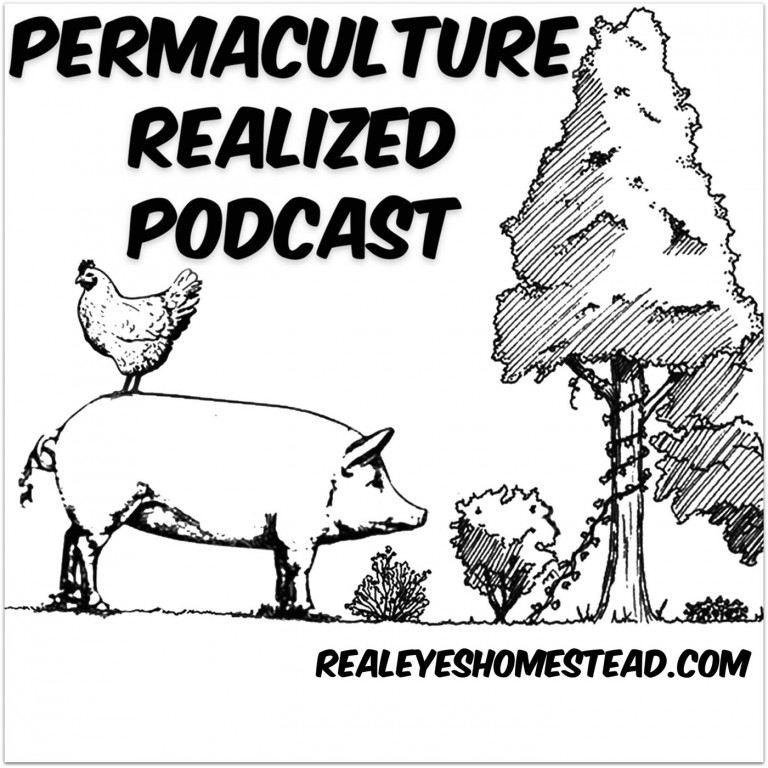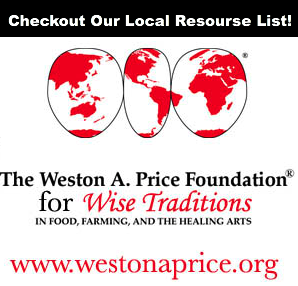Hey friends!
In this video, I’m going to walk you through some of the first steps to getting started with homesteading and permaculture.
In previous videos, I focused more on the “why” permaculture and homesteading are more than just cool hobbies but are actually important responses given our current historical context. So, in this video, I’m going to focus more on the “how” to get started for those who are ready to get their hands dirty.
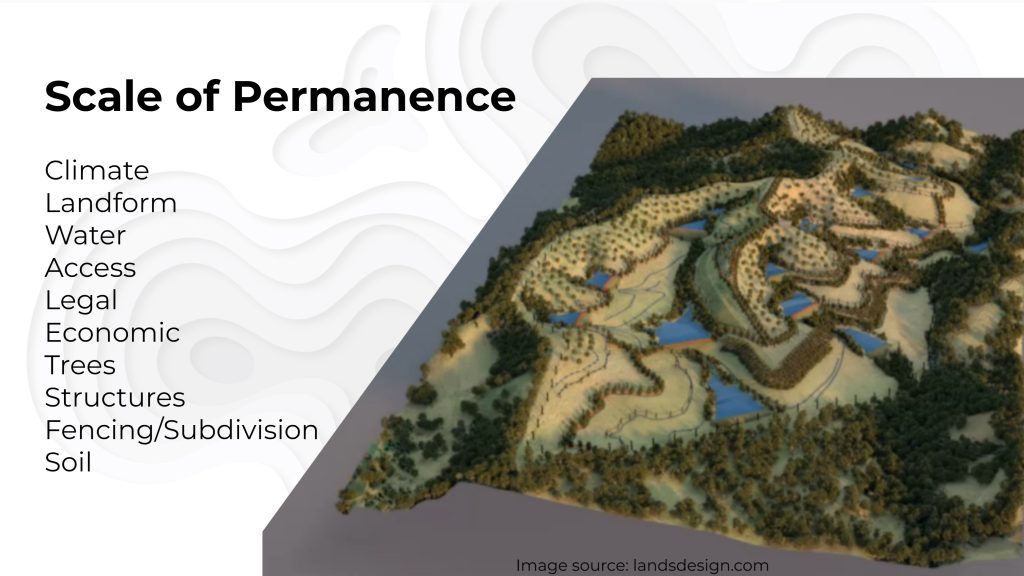
Now, maybe you don’t have land yet. That’s okay. This info will still be really useful. I’ll be covering everything from climate to landform, wind, water, soil and more. That being said, I highly recommend that you just start wherever you’re at right now, instead of waiting until you have land one day.
Site Analysis and Assessment
Whether you’re renting a tiny city lot, or you own a huge 100 acre farm. It’s important to understand the site conditions before you make any big decisions. I’ll be walking you through a process called site analysis and assessment, and I’ve included a link to a handy site analysis checklist here. To help you get started.
Quick note on where this info is coming from. It’s mostly based on my study of Edible Forest Gardens by Dave Jackie with Eric Toensmeier, as well as my 10 years of experience as an amateur homesteader.
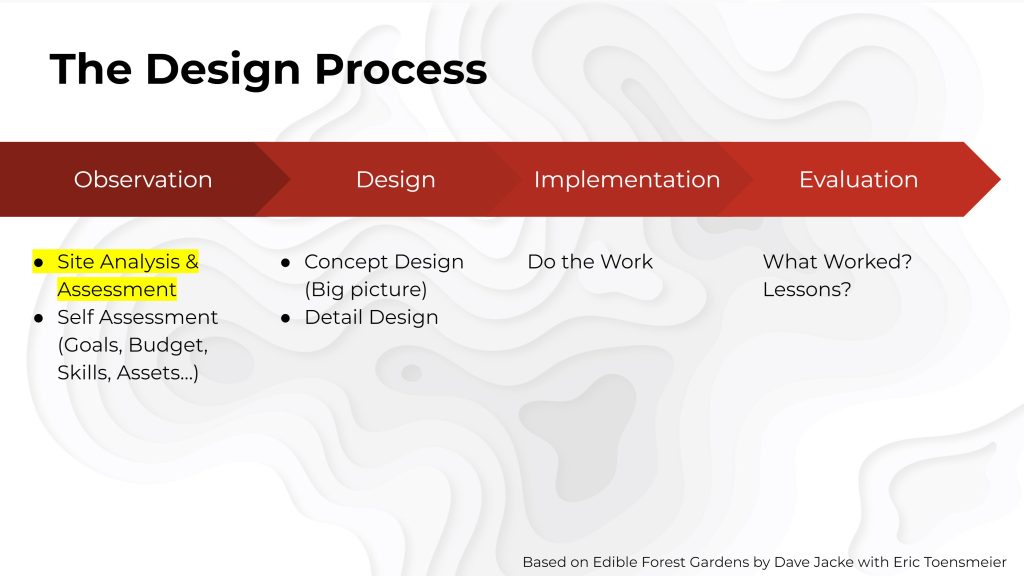
We’re mainly focusing on the observation stage of the design process. As you can see, it’s also important to take some time in these early stages to analyze and assess yourself or your family. What are your goals, constraints, your skills, weaknesses, assets, tools, resources, and budget and connections. Ultimately, your design for your homestead will bring together your understanding of yourself and your site. So, as with all things, awareness is key.
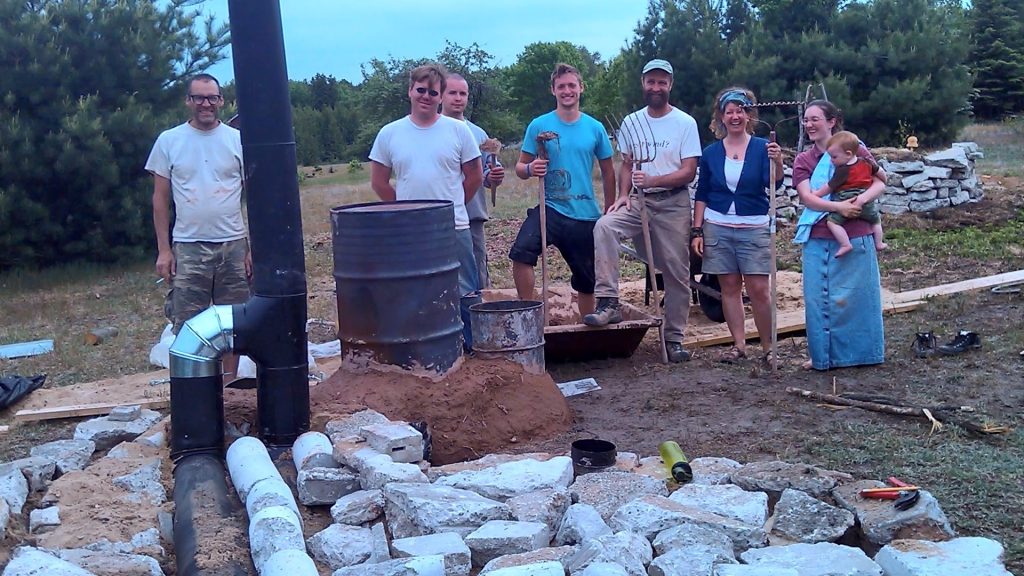
One mistake I made early on in my homesteading journey was to approach the site with an attitude of “what can I get from the land”, or “I want a rocket mass heater because they’re cool. So I’m just going to put one right here.” Basically just forcing my ideas onto the land as though it was a blank canvas. I’ve learned that it’s important to flip this framing on its head, and instead approach the site as though it’s a finely tuned orchestra in mid-performance. It would be very rude to come into a quiet Piano Concerto and start blaring my jazz trumpet solo.

So I learned it’s important to listen and pay attention first.
Soil
For instance, I noticed that there’s a line about in the middle of my property where there’s a distinct change in vegetation. You can see this wavy tree line running north and south here. Now, is this due to some natural phenomena? Or is it the result of human management?
We don’t have enough information yet. But the wavy shape might give us a clue. I could try to go talk to someone with more history on the land. And that’s also an important part of getting started reconnecting with the land’s previous human inhabitants, both recent generations and ancient ones.
But right now, I’m going to start looking for more clues in the landscape, such as looking closer at the soil and ground vegetation. When I do, I notice that on the east side, there’s a lot of grass and moss. On the west side, the plants are a lot more sparse and spindly, and there’s more exposed sandy soil and no moss. Now, are these differences caused by the nearby trees? Or are the trees and grass both being affected by some unseen forces at play?
Next, I might want to get a closer look at what’s going on underground to continue my detective work.
Digging a few holes will require me to start having an impact or adding my voice to the orchestra. It’s best to start with small interventions and build on what works. In fact, there’s no such thing as a passive observer. By simply existing in the current industrial economy. We’re having a huge impact on vast landscapes far away that we’ve never seen and rarely think about.
So I went and dug a couple holes.

The top layer of darker material is called the topsoil. This is built up by decaying organic matter of living organisms and holds many essential nutrients and a whole community of soil organisms that all help plants grow. Below is the subsoil, which tends to have less organic matter and mostly just raw minerals.
A great first step is to get some soil tests done of your topsoil and subsoil to see what nutrients are abundant and which are lacking, as well as the soil pH and other factors. You can also do a simple jar test to learn your soil texture, which is basically how much sand silt and clay the soil is made up of. You can also try pouring a bucket of water in the hole and See how quickly the water infiltrates into the ground.
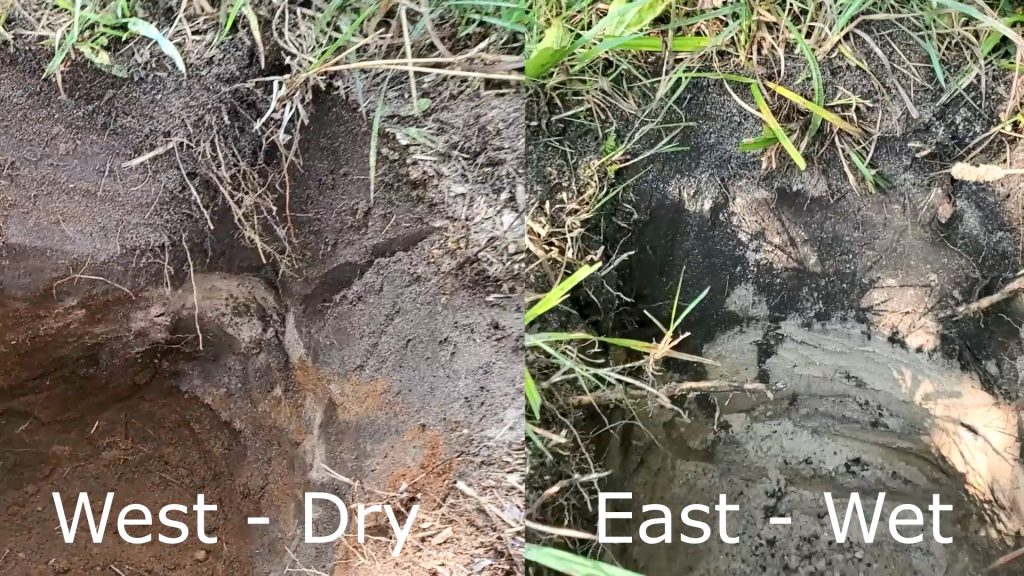
Check out the difference in the color and depth of the soil layers in these two holes. It’s very distinct. When I did soil tests from my site, I found that the wetter area tends to have much higher organic matter and a higher pH. While this drier side has very nutrient-poor soil and a low pH, meaning it’s more acidic.
There’s also a great online resource called the USGS soil survey, where you can look up the soil type of your site. If you’re based in the US, you can likely find similar tools in other countries.
 And look at that, bingo. The most likely cause of this change in vegetation that I observed is due to the very different underlying soil types.
And look at that, bingo. The most likely cause of this change in vegetation that I observed is due to the very different underlying soil types.
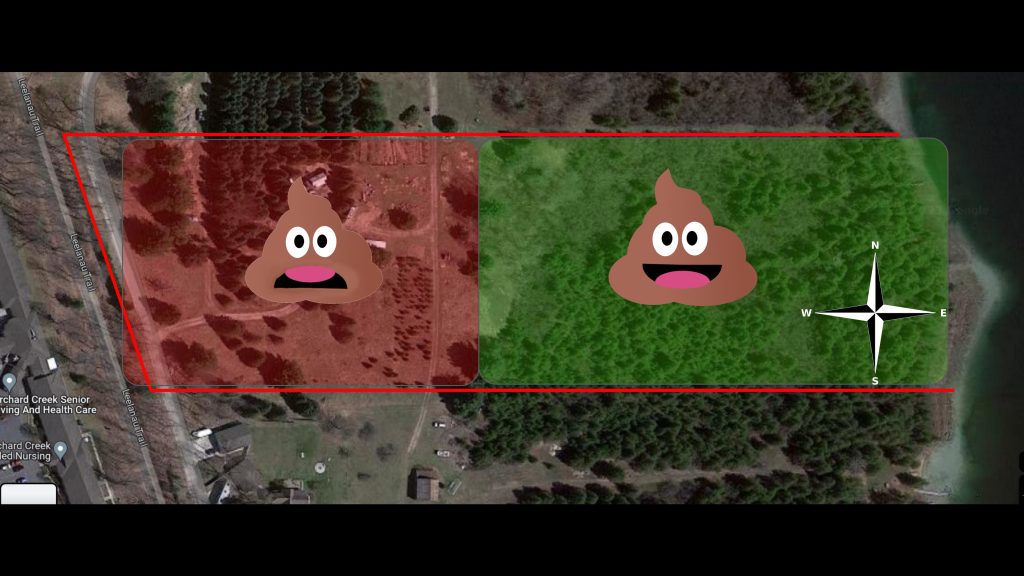
This understanding dramatically affects the decisions I make for these two distinct sides of my site. This is where our observations start to guide us towards design solutions. One of my goals is to grow a lot of food. But clearing this native wetland where the soil is fertile, is ecologically questionable, and I don’t think they would appreciate it. But then again, the soil fertility is poor in the open areas. So, my goals combined with the site conditions mean that I’ll need to do a lot of soil building work.
Site Repair
In edible forest gardens, there’s an important principle called site repair. While it’s tempting to move into beautiful, intact ecosystems, and start deploying our schemes, our civilization has left a lot of landscapes damaged. Even if we didn’t necessarily choose that, I think it’s important that we take some responsibility.

Loess Plateau, China – Ecosystem Restoration Project 1994 (left) to 2009 (right)
But the good news is that the power goes both ways. We can also play a powerfully healing role in ecosystems, building soil and creating wildlife habitat, while providing for our own needs. So perhaps the right place is for us to inhabit these damaged and abused lands and work to heal and restore them.
Wasi’chu
The impulse to escape into pristine ecosystems reminds me of this Native American expression; Wasi’chu, which is a Siouan word that means “he who takes the fat.” This is a reference to someone who always takes the best piece of meat or cake at a meal, and was often used to describe the greediness of the non-native settlers.
So, by doing my building and growing on the side with poor soil and working to improve it, I’m practicing this principle of site repair.
One way to build soil is with compost!

This year, we started a food waste pickup service for the local organic food Co-Op. The old produce that isn’t good enough for the local food bank gets placed in bins. And once a week, my landmate Tom goes and picks it up with the truck and trailer, then we unload it here at Realize Homestead and create a compost pile inside the chicken pen. This food would otherwise go to the landfill. So the Co-op is happy to pay us to haul it away and compost it for them. Not only are we getting some revenue coming in, but it’s also providing free feed for the chickens and pigs, who give us eggs and pork and fertility for the soil.
The system is working great now, but I’m going to keep observing how it affects the soil and pasture vegetation over time, as well as the chickens themselves.
The Design Process – Cycle
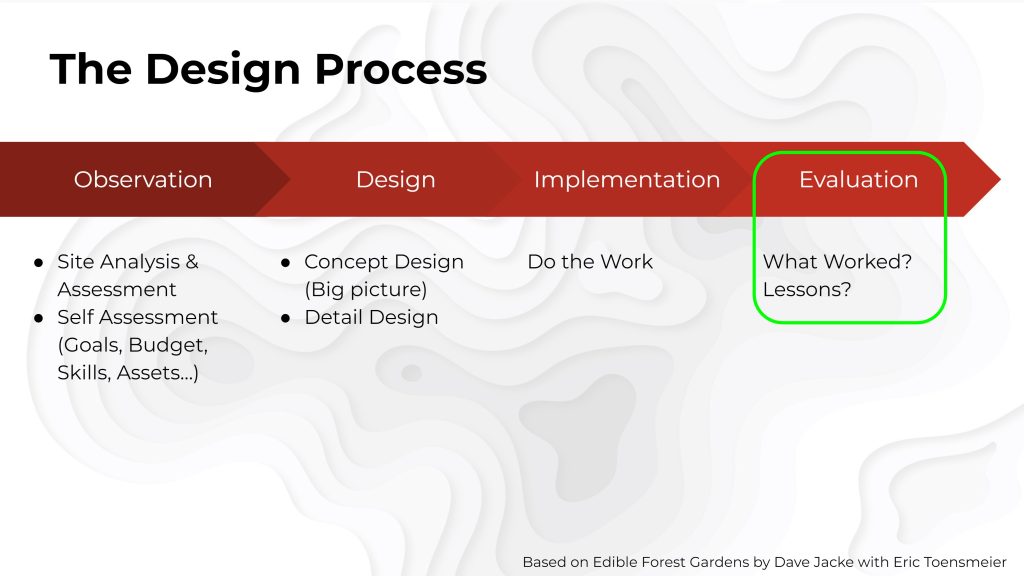
This is the evaluation step of the design process. Design isn’t a one-time process. It’s a cycle that you keep going around and around on implementing designs, seeing what worked and didn’t, and incorporating that into the next cycle or season.
The design and implementation steps are like breathing out. You know, you’re building things, changing things, adding things doing stuff, right? So you’re projecting from your inner visions and plans outward on the landscape. But it’s important, you know, in any kind of dialogue or dance, to also take the time to receive or breathe in. And that’s the evaluation and observation steps of the design process, you know, observing the landscape and observing the impacts that your actions are making on it.

So, homesteading and doing Permaculture is less like implementing an engineering plan. And it’s more like a dance or a dialogue with an alien intelligence that you’re trying really hard to understand and cooperate with.
Scale of Permanence
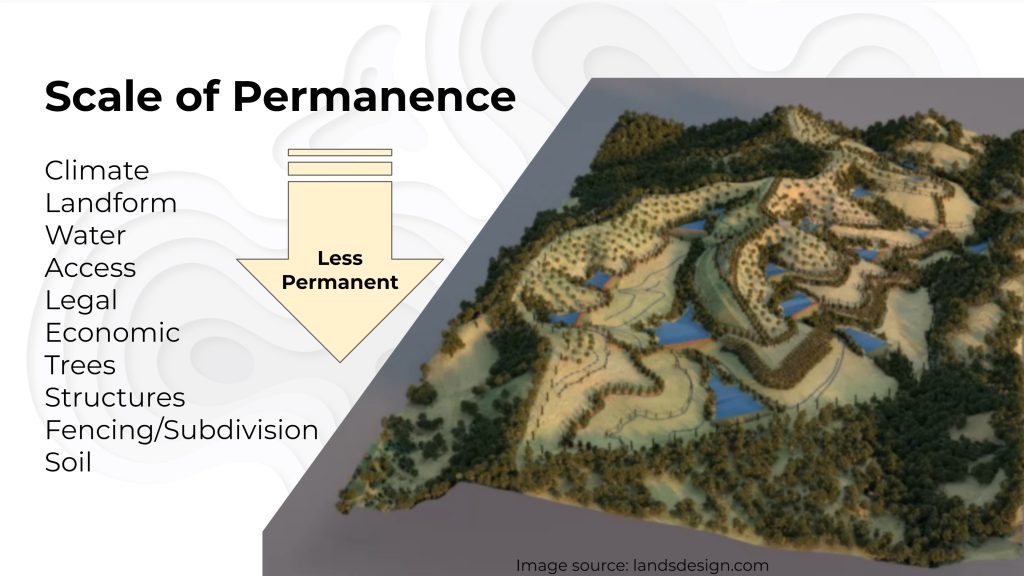
Now, let’s look back at the Scale of Permanence. The items listed from the most permanent and hard to change to the least permanent and easiest to change. And this falls under the Site Analysis part of the design process. We kind of started towards the bottom since the soil of your site is actually easier to change than the climate.
Climate
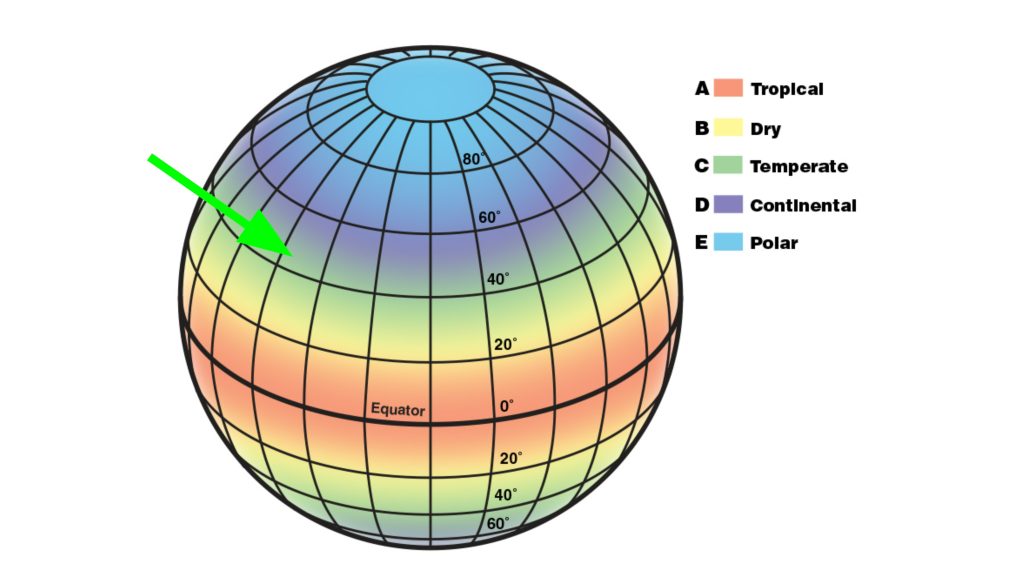
So, what are the most important climatic factors to pay attention to? First of all, there’s approximately five main climate types on Earth: tropical, dry, temperate, continental and polar. Since I live near the 45th parallel, that’s towards the cold side of the temperate climate. And we have four seasons and fairly long cold winters with lots of snow.
This is important to know because I’ll need a very different type of house. And I’ll grow very different plants compared to someone in a tropical climate or a polar climate. So when I’m researching things like which nut trees to grow that produce a lot of protein, I would want to qualify my research by adding which climate type I’m in, so that I get relevant information to me.
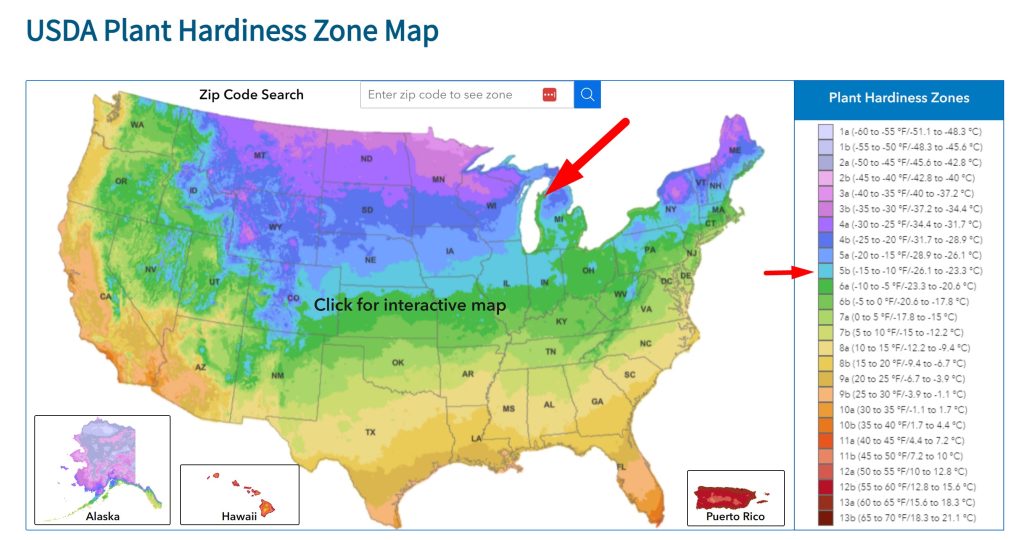
Now, there’s also a system called the USDA growing zones, which is kind of like a more fine-tuned version of the five climate types. And it can be used to specifically narrow down which plants you can buy. Now, this is a US program, but there’s similar systems in Europe and other countries. But anyways, I’m in growing zone 5B, so when I’m shopping for plants, I’d want to look at what growing zones they can survive in outdoors and make sure that that they can make it and growing zone 5B.
These growing zones have a lot to do with the earliest and latest frost date in that location. So your frost dates are basically when the air temperature drops below freezing, because a lot of plants can’t survive freezing temperatures, or they need to be already in their dormant state to deal with that.
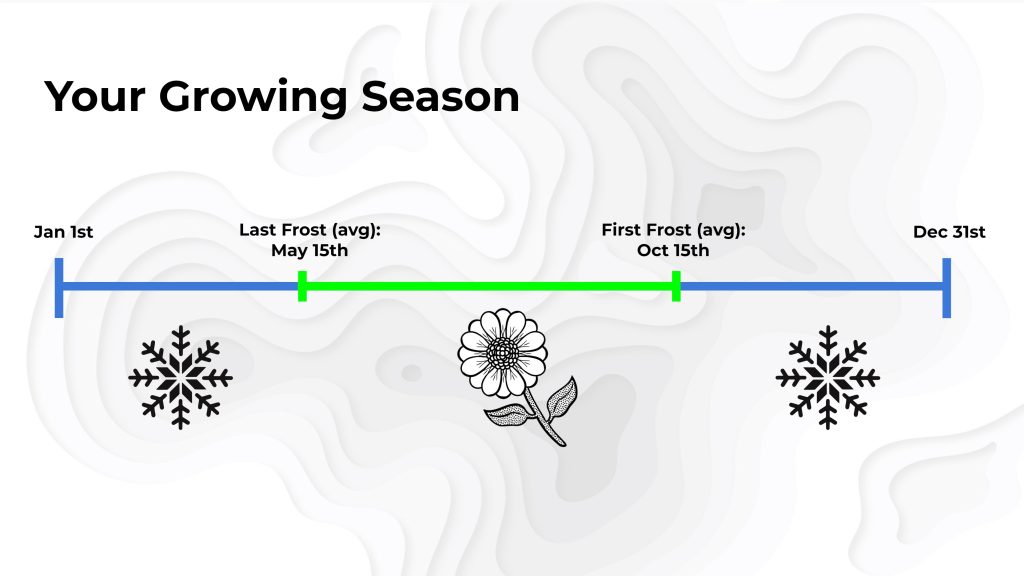
So the first frost date would be in the fall as the winter is coming. It’d kind of be like the average date that you would experience freezing temperatures, typically at night. And so where I live, it’s in mid-September. And this really matters for things, you know, that you’re growing in the garden. So you need to make sure that you plant them early enough in the season, that they can grow to maturity, and you can get your crop before they get killed by frost.
Now, the last frost date happens in the spring at the end of winter, and is the latest into the spring that you, on average, might still experience freezing temperatures at night. So, where I live, that’s usually late May or early June.
Climate Change and Assisted Migration
Now interesting fact about the growing zones is that they’ve actually been changing quite rapidly. In just the last few decades, some places have changed more than one whole growing zone getting basically getting warmer.
And that’s pretty problematic, especially for our native species that, you know, have adapted to grow in one climate. And this change is happening so fast that they can’t necessarily migrate quickly enough to keep up with the changing climate as their habitat moves northward.
So some of the work we can do in addition to, you know, planting species we want to grow is helping native species with this northward migration as the climate shifts.
Microclimates

Now in addition to the macroclimate that affects your site, there’s also this concept of microclimate. Basically different spots on your land where the climate is slightly warmer, cooler, wetter, or drier than these general macro trends due to factors like trees, buildings, slope, and more.

For instance, this apple tree I planted in the shade of these pine trees. And it’s actually grown a lot more than the trees that I planted just out in the open. I believe that’s because the shade has helped reduce the evaporation in the soil, keeping it more moist, which has helped the apple tree grow.
This is actually a strategy that we can use to get trees established. We can plant what are called nurse trees or pioneer trees that are really fast growing and kind of can deal with harsher environments, get them growing first, and creating microclimates, and then get our more sensitive, maybe our fruit trees.
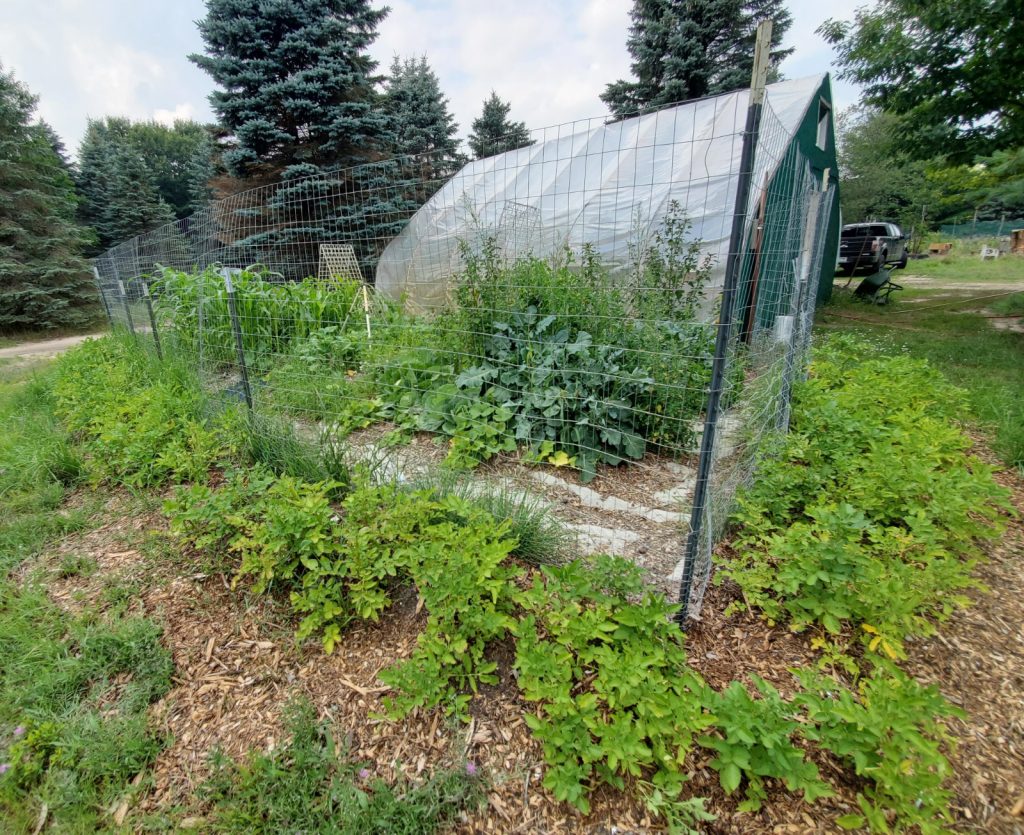
Another example of a microclimate is this plastic greenhouse or hoop house that creates a modified microclimate with a longer growing season. So we can grow plants both earlier and later in the year than we would be able to just based on the macro climate.
In the summer, it gets extra hot and dry in here, so we can use that hot, dry microclimate as a place to dry herbs and seeds.
Wind
The next item on our site analysis checklist is wind. You can do a little research to find out what is the prevailing wind direction on your site. And wind can be actually really damaging. Recently, I had a really big spruce tree get blown over on my property. And what’s interesting is when I looked at the prevailing wind direction, it actually blew in the exact direction that the prevailing winds go. Also typically, the winds will shift a bit during the winter and summer. So pay attention to that.
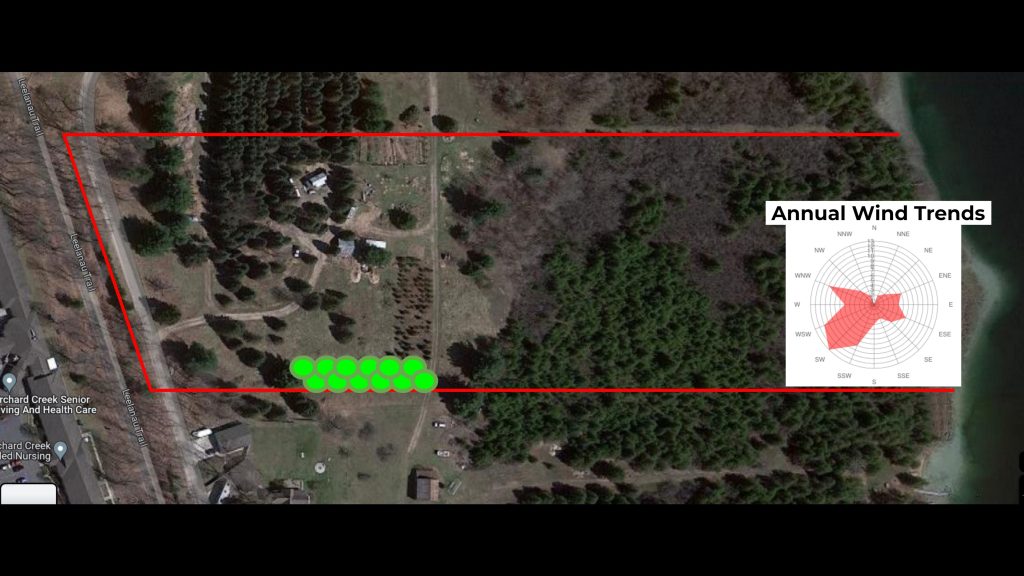
How you can apply this is planting a windbreak upwind of your site, like I’ve done on the southern boundary of my property right here.
Sun Angles
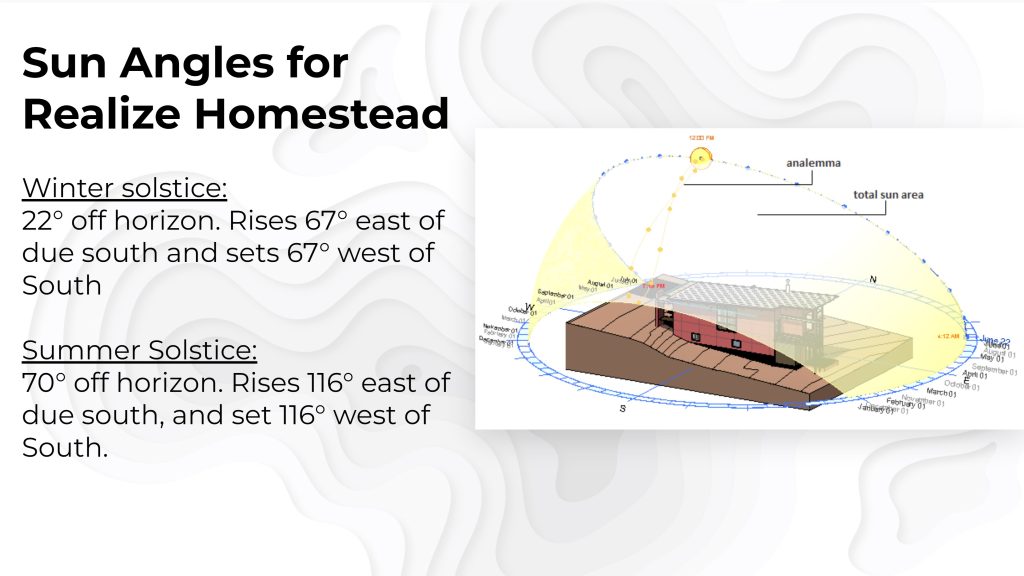
Alright, the next thing to look up is your sun angles. Depending on where you live on this globe…and I do believe it’s a globe-shaped planet that we live on. 😉 It’s going to affect the angle and trajectory that the sun travels through the sky above your location. But what do all these numbers actually mean?
So essentially, as you hopefully know, the sun rises in the east and sets in the west, but it doesn’t always go the same arc across the sky. Now, during the summer, at least where I live in the northern hemisphere, the sun does go almost directly overhead in the middle of the summer or the summer solstice, which is the longest day of the year, and that’s in late June, but then throughout the year, as the Earth orbits around the sun, and the northern hemisphere then is tipping away from the sun as we get into winter, which is actually what causes the seasons is the tilt of the earth as it orbits the Sun, and that’s why the southern hemisphere which is tilting towards the sun as their seasons opposite…but as we’re tilting away in the northern hemisphere, then the sun, from our perspective, is getting lower in the sky.
It still rises in the east and sets in the west, but it tracks a lower arc across the sky and stays further down in the southern sky, from our perspective. Because of that, the days are shorter, especially on the shortest day of the year, which is the winter solstice, which is just before Christmas. And why this is important is so that you know where the shadows are going to be throughout different times of the year. And you can use that when you’re planting plants or building buildings, you’re positioning your hoop houses or greenhouses or your solar panels. The sun’s angle, and aspect really matters.
Landform
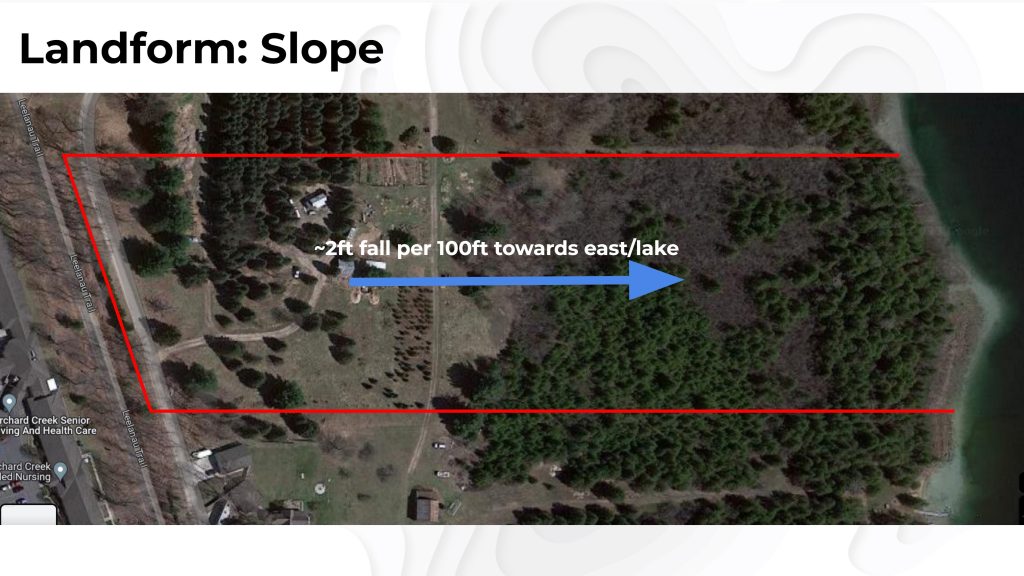
Okay, so those are all parts of climate. So the next item on the scale of permanence is landform, or basically slope. Now my particular property, there’s actually not a lot of slope going on. But slope can actually have a really big impact, especially when it comes to water runoff and also soil temperature, depending on what angle it’s sloping towards or away from the sun, as well as how difficult or easy it is to navigate around different parts of your site.
You can also probably find a topographic map of your site online, which can give you a general or low-resolution sense of the high and low spots and where the slope is angled. But ultimately, you just gotta get out there and walk the property and get a feel for it.

Some quick rules of thumb to keep in mind are that hot air rises and cooler air sinks. So if your site has a low spot where cold air might collect and nowhere for it to drain away, then you might have a frost pocket that’s unusually colder than the surrounding area, a little cold microclimate that can really affect your plants and buildings and everything. So don’t build your house in a frost pocket.
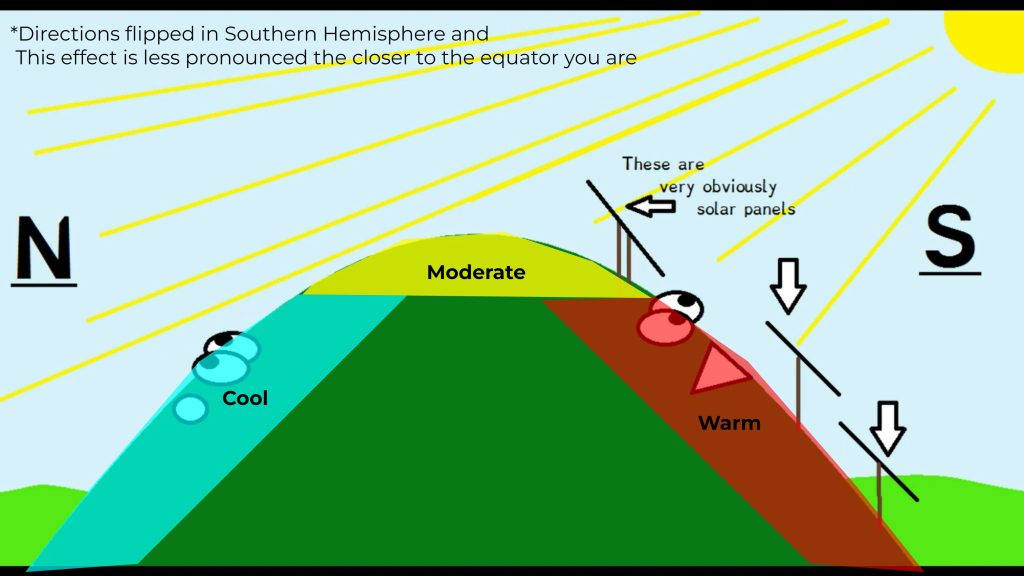
Now one thing to consider about slope is how the sun affects the soil temperatures. If you think about solar panels, again, they’re generally slanted towards the south, at least in the northern hemisphere, so that the rays of the sun are most directly hitting them. And so if your land is sloping in that same direction, it’s going to absorb a lot more of the sun’s energy. And so it’s going to heat up a lot faster and sooner in the year than elsewhere on your site.
Typically, the south-facing slopes are where the snow will melt earliest in the year. And that’s actually a pretty good trick to identify microclimates is to pay attention to where the snow is melting in the spring soonest and where it kind of sticks around.
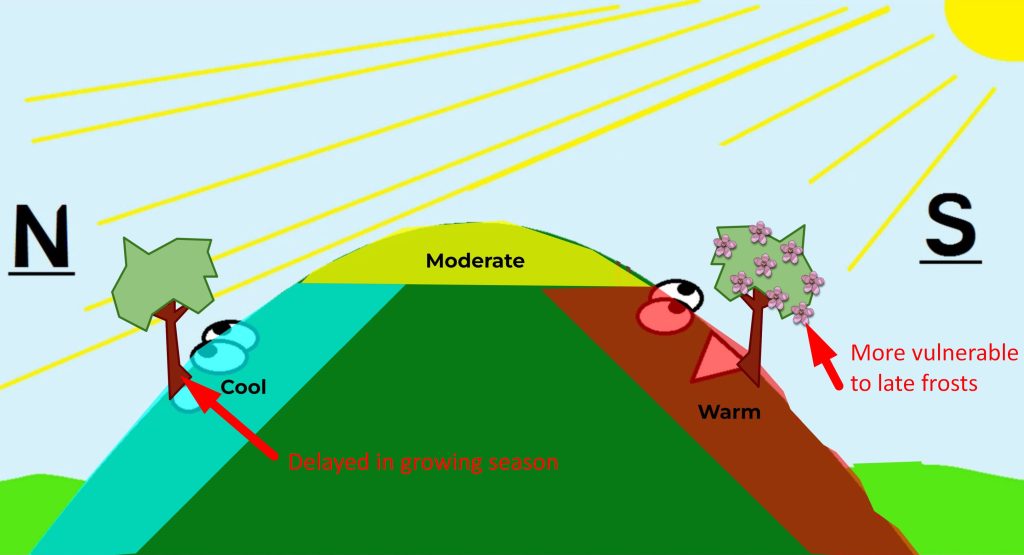
So now, thinking back for a second to the frost days. So, if you plant a fruit tree on a south-facing slope, that heats up earlier in the year, then that tree might get the signal to start leafing out and producing its buds and flowers earlier in the year because of the soil temperature. So you could still have a late frost that then kills off all the blossoms of your tree because it came out a little too early. So, if you have fruit trees that are sensitive to late frosts, you might think about planting them on a north-facing slope away from the sun so that their timing is a little bit more delayed in the season.
Slope can also come into play when you’re designing elements on your site. Ideally, any heavy, bulky materials, for instance, your woodchips and compost for your garden, it’s nice to have those upslope of your garden so that…if you think about filling up your wheelbarrow, it’s easier to have a heavy wheelbarrow going downhill, and then you empty it in your garden. And so then, as you’re going back uphill, you have an empty wheelbarrow.
Water
Okay, next on the scale of permanence is water. I can kind of hear the water…
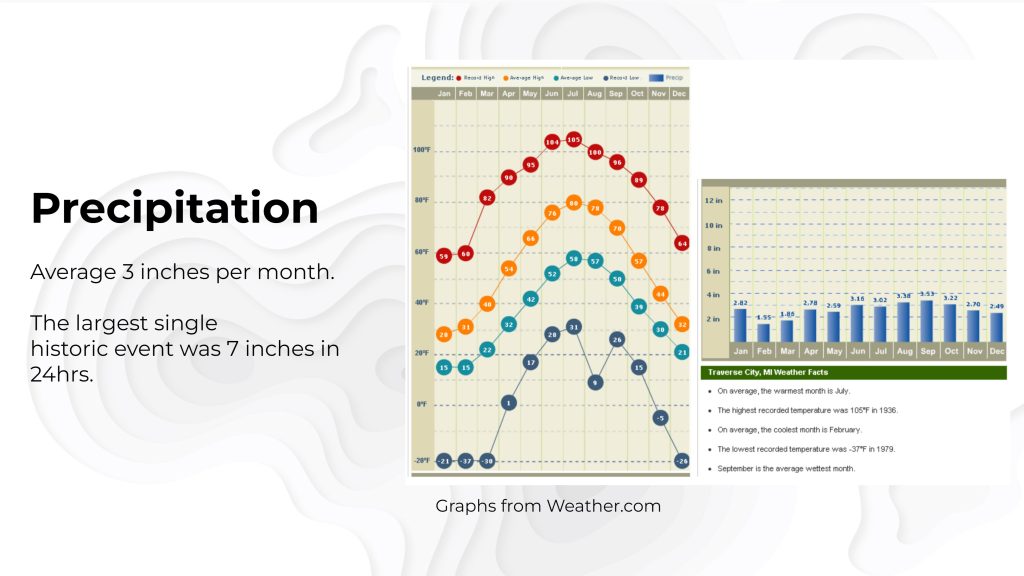
So first of all thing to be aware of is your precipitation. For instance, here we get, on average about three inches of precipitation per month. And the largest single historic event was seven inches and 24 hours. And again, that can be very important when it comes to flooding. And actually, you should really know if you’re in a flood zone. They’ll often even be cited on your deed or title to the property because they’re so important. And they affect insurance, stuff like that.
Watershed

Now, if you zoom out from your site and look at the surrounding landscape, you can begin to get a sense of your watershed. This is basically the network of natural pathways that all the water takes when moving over the land flowing down into streams and rivers, lakes, and oceans.
Again, this is important. First of all, in case there’s a lot of catchment area above your site that could send enormous amounts of water in your direction during a large rain event. Or if there’s some sort of pollution source that could be polluting your water that’s upstream of you in your watershed.
Global Trends
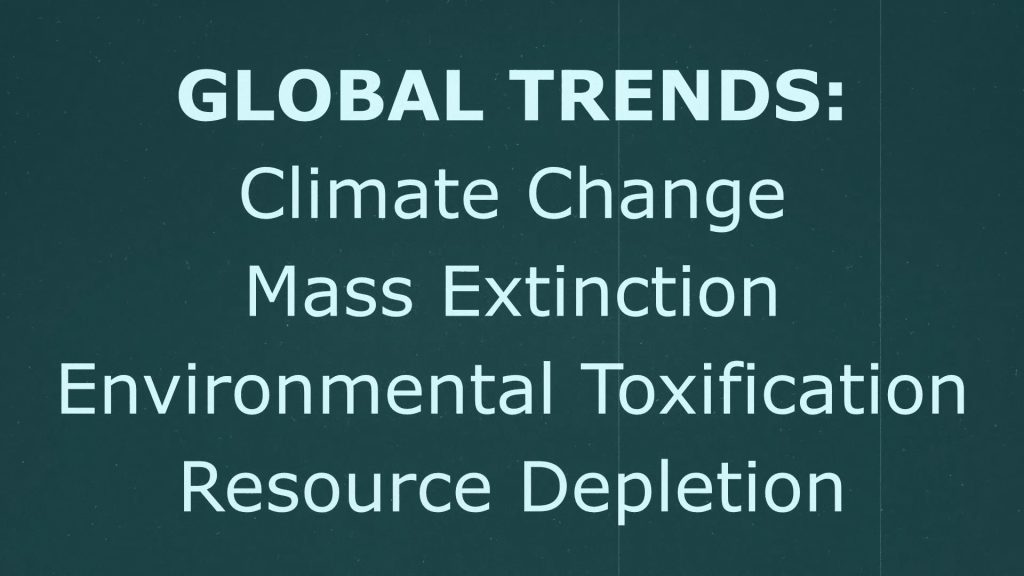
Now, in my previous videos I actually zoomed out even further and talked about the global context and trends that influence all of our sites, the upstream factors of our present moment in time, a sort of global site analysis and assessment, just to give a little conceptual context here, but back to water.
Water Table
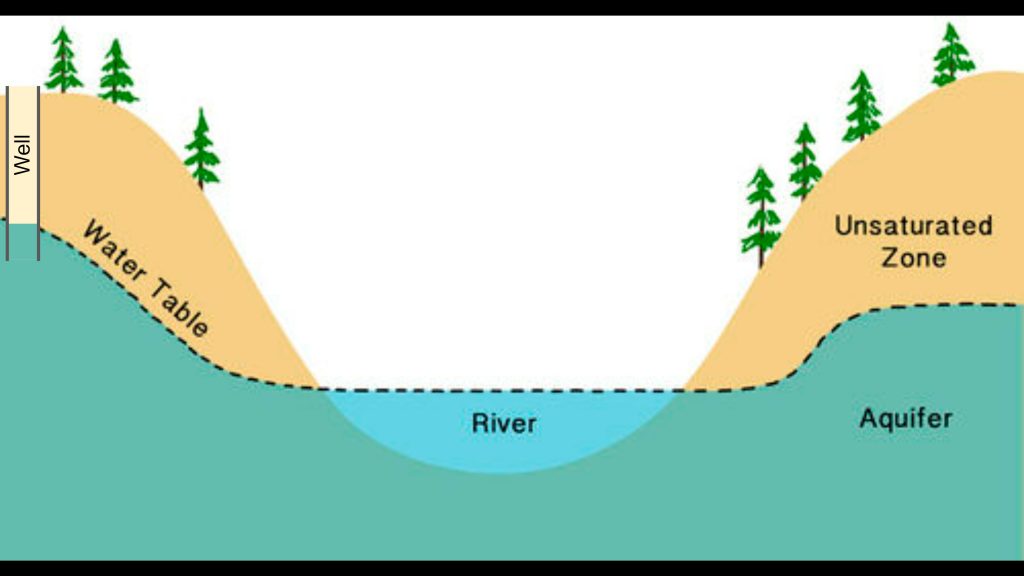
So beneath the ground is the water table. So if I dug a hole deep enough, eventually, I would hit standing water. I mean, that’s basically the idea of the old-fashioned wells right with brick walls. Now modern wells don’t really look like that. They’re basically just a thin tube going really, really deep in the ground to access the freshwater deep down.
So that’s the water table. And generally it follows the contours of the land, but it can be very shallow or very deep. And there can definitely be problems with that to both depletion and pollution of groundwater tables to pay attention to
Now, on the drier parts of my site, the water table is roughly about 15 feet down. And this is also important to know when you’re digging wells or basements or root cellars.
Underground Microclimates – Root Cellar

Underground is actually another important microclimate that you can utilize to your advantage, such as in this root cellar.
Here, where I live in Michigan, if you go more than five feet down in the ground, then the temperature tends to stay right around 55 degrees Fahrenheit year-round. That’s really useful because if you have water lines that are going between buildings, then you can bury them at least five feet underground to prevent them from freezing.
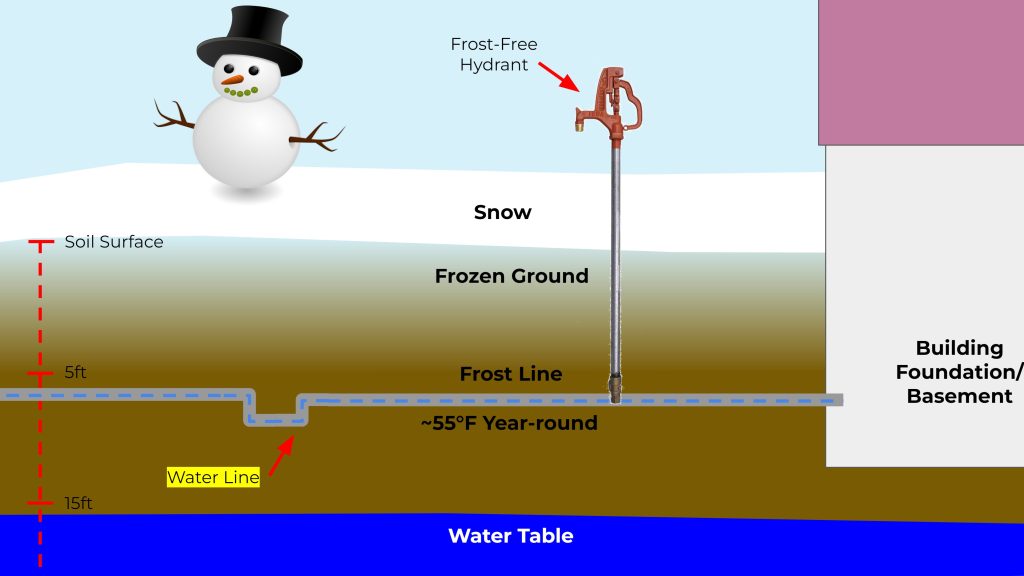
So the depth at which the ground never freezes in an area is called frost line. And it’s really useful to know. So we can use this underground microclimate that stays at that moderated cool temperature year-round. For passive food storage.
Many crops can be stored down there for months, with no extra refrigeration, things like potatoes, beets, carrots, cabbage, and more. Plus, I can store canned goods and not worry about them freezing during the winter and cracking.
Now, I know some of this stuff is really basic for some of you. But as someone who came into this with completely no experience or knowledge, I found that I lacked a lot of the basics. So, I’m just trying to make sure to fill in any gaps and knowledge that might be out there. So, this root cellar is still under construction. I’ll be adding a bunch of shelves in here for food storage and piling more Earth on top of it. But we’re already taking advantage of this cool temperature. I also put a chest freezer in here for all the pork and venison.
Legal
Another important aspect to pay attention to about your site. Are the legal systems in place.
Do you live in a homeowner’s association, or HOA that restricts your freedom to raise chickens or grow gardens in your yard?
Do you need a land use permit from your local municipality in order to build structures over a certain size?
Is it legal to collect rainwater where you are?
Chances are something you want to do is going to be illegal. Instead of giving up, I would encourage you to challenge unjust laws. I personally believe it’s a basic human right to provide for our own food, water, and shelter. So, part of the important work we can be doing here is confronting some of these unjust laws through civil disobedience and grassroots organization.
This is also why it’s important to meet your neighbors where you live. Maybe share some produce or eggs with them. That’s what neighbors are for; to look out for each other. So be a good neighbor. Be trustworthy and reliable.
Economics
If you’re considering farming as a business or side income, then it’s also helpful to understand local economic factors. For instance, which farmers markets are near you, and which products might be oversupplied or in demand.
And cooperatives can be really powerful.
In Michigan, there’s a chestnut growers cooperative. The cooperative handles all the processing, the marketing, the selling, basically all the business side of it, and then the co-op returns a fair market value back to the growers so they can focus on what they do best; growing the crops. Maybe there are similar organizations near you!
Existing Species
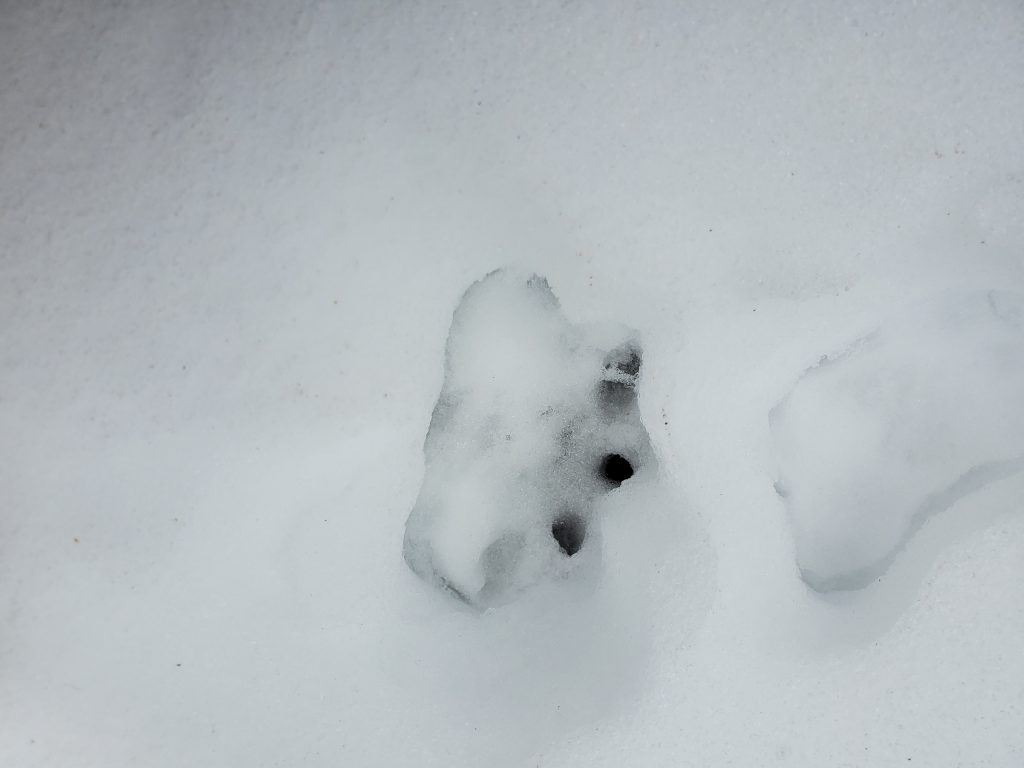
Moving further down the scale of permanence, again, we get to existing species. And it can actually be a lot of fun to try identifying different plant and animal signs on your land, especially if you get kids involved. And by paying attention to what the existing plants are growing, it can give you clues to what will actually grow well on your land.
For instance, we have a lot of wild cherry, wild grape, and oak. We would probably have success with cultivated grapes, cherries, and possibly other nut trees like chestnuts and hazelnuts.

Because what we’re really trying to do here with our homesteads is integrate with the native landscape; to join and enhance the music that’s already present on the land.
Basically, it’s creating our own human habitat to live within, that blends into and complements the native ecology.

Considering the types of habitats being created by the status quo that are defective in almost every way, it’s not hard to do better, even if you feel unqualified or underfunded. In the words of my good friend Cory, “If you have to fix everything, start anywhere.” Even if that’s just the abandoned margins between lots with whatever materials and resources you have on hand. You don’t need 20 acres out in the country.
Conclusion
When I moved back home to this vacant property with no homesteading or practical skills to speak of, it was really overwhelming. And I made a lot of costly mistakes. There’s so much you can learn at the small scale. In general, you probably have a better support network wherever you’re at right now anyway, so don’t quit your day job.
But if you are thinking of moving or buying land, please keep in mind the principle of site repair.
Now, I’ve focused a lot on understanding the land and the site you’re on. In addition to our relationship with the land, one of the most important relationships that we have is with ourselves. It might seem off-topic, but it actually really matters.
If you’re really hard on yourself when your plans fall through or you drop the ball, then homesteading is going to be hard and frustrating. Instead, if you give yourself permission to make mistakes and learn from them, that will be much easier and even fun.
Although mistakes can still be a little painful.
I’ll leave you with one last quote from the Chinese farmer and philosopher Masanobu Fukuoka;
“The ultimate goal of farming is not the growing of crops, but the cultivation and perfection of human beings.” – Masanobu Fukuoka
Don’t forget to grab that Site Analysis Checklist here.
Thanks for reading/watching.
Happy homesteading.
😀
